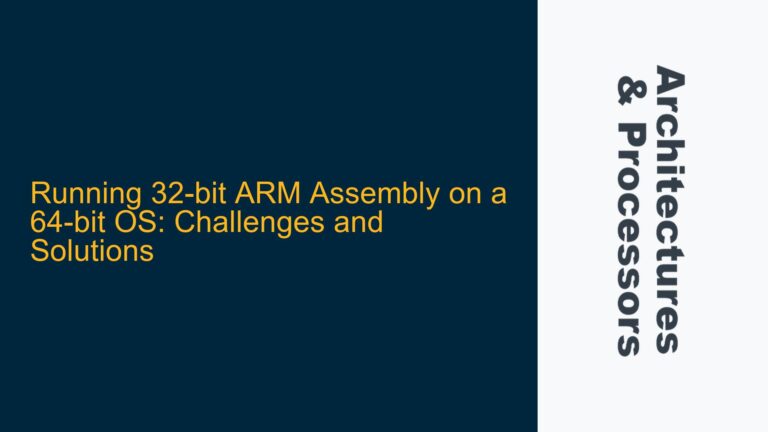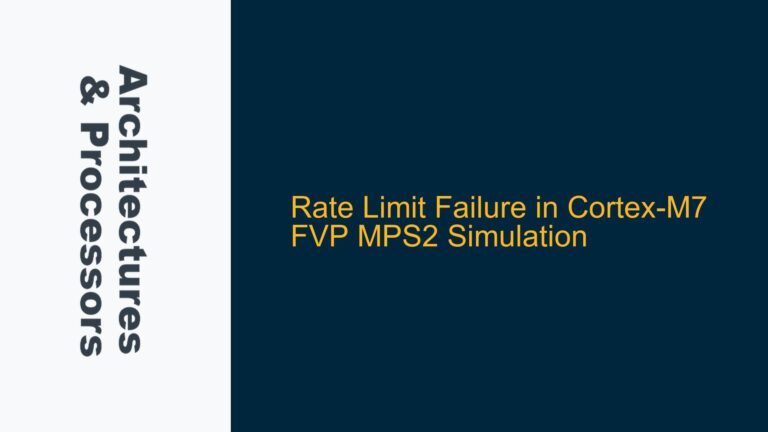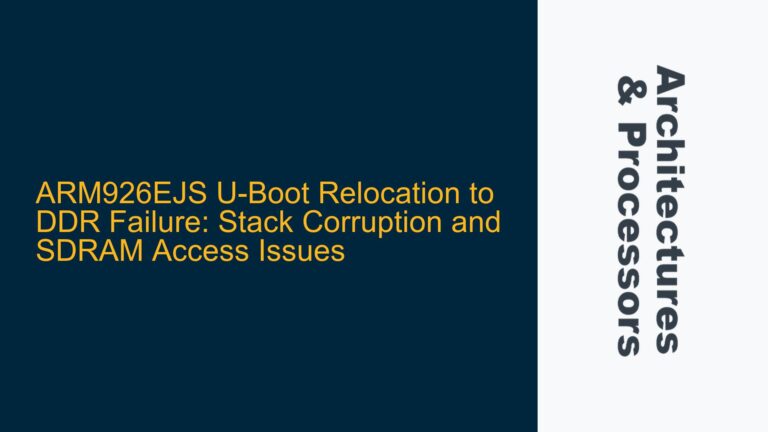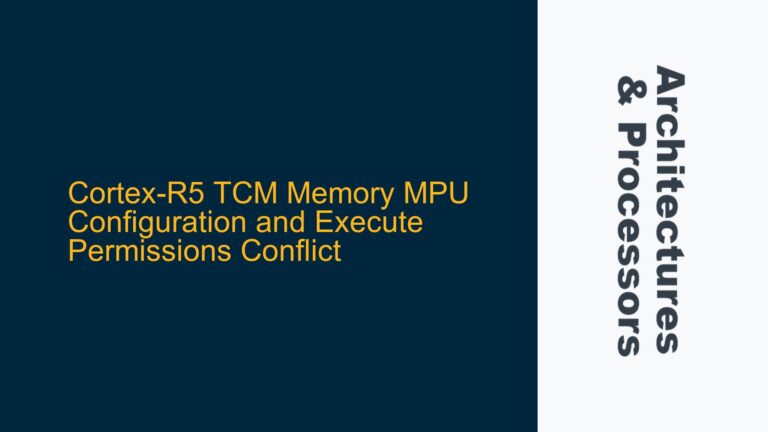ARM Cortex-M4F Complex Matrix Inversion Performance Bottlenecks
The ARM Cortex-M4F processor, known for its efficiency in embedded systems, faces significant challenges when performing complex matrix operations such as a 6×6 complex matrix inversion. The Cortex-M4F, while equipped with a Floating-Point Unit (FPU), is optimized for single-precision floating-point operations, but complex matrix inversion introduces additional computational and memory access complexities. The primary issue lies in the inherent computational intensity of matrix inversion, compounded by the need to handle complex numbers, which doubles the data size and increases the number of arithmetic operations required.
Matrix inversion is an O(n³) operation, meaning the computational load grows cubically with the matrix size. For a 6×6 matrix, this results in 216 operations for the determinant calculation alone, not including the additional steps required for the adjugate matrix and final inversion. When dealing with complex numbers, each multiplication and addition operation involves four floating-point operations: two for the real parts and two for the imaginary parts. This quadruples the computational load compared to real-number matrix inversion.
The Cortex-M4F’s FPU, while capable, is not designed for such heavy workloads without optimization. The processor’s single-cycle multiply-accumulate (MAC) operations are beneficial, but the lack of a dedicated complex number instruction set means that each complex operation must be broken down into multiple real-number operations. This increases the instruction count and can lead to pipeline stalls, reducing overall throughput.
Memory access patterns also play a critical role. Complex matrices require contiguous memory storage for both real and imaginary components, which can lead to cache inefficiencies if not managed properly. The Cortex-M4F’s memory subsystem, while efficient for typical embedded workloads, can become a bottleneck when dealing with large data sets like a 6×6 complex matrix. The processor’s limited cache size and bandwidth can lead to frequent cache misses, further degrading performance.
CMSIS Library Limitations and Complex Number Handling
The CMSIS (Cortex Microcontroller Software Interface Standard) library provides a robust set of functions for matrix operations, but its support for complex numbers is limited. The library is primarily designed for real-number matrices, and while it can be adapted for complex numbers, this requires significant manual intervention. The lack of native complex number support in the CMSIS library means that developers must implement custom functions for complex arithmetic, which can introduce inefficiencies and potential errors.
One of the main limitations of the CMSIS library in this context is its reliance on real-number matrix operations. For example, the arm_mat_inverse_f32 function can invert a real matrix, but it cannot directly handle complex matrices. To use this function for complex matrices, developers must decompose the complex matrix into two real matrices—one for the real components and one for the imaginary components—and then perform the inversion separately. This approach not only doubles the computational load but also introduces additional complexity in managing the intermediate results.
Another limitation is the lack of optimized functions for complex matrix multiplication. The arm_mat_mult_f32 function can multiply two real matrices, but for complex matrices, developers must implement a custom function that handles the four multiplications and two additions required for each complex element. This custom implementation is often less efficient than a native complex number function would be, leading to increased execution time and potential numerical instability.
The CMSIS library’s memory management also poses challenges. The library assumes contiguous memory storage for matrices, which is straightforward for real matrices but becomes more complex for complex matrices. Developers must ensure that the real and imaginary components are stored in a way that minimizes cache misses and maximizes data locality. This often requires custom memory allocation strategies, which can be error-prone and difficult to optimize.
Optimizing Complex Matrix Inversion on Cortex-M4F: Techniques and Best Practices
To achieve efficient 6×6 complex matrix inversion on the ARM Cortex-M4F, several optimization techniques and best practices can be employed. These include leveraging the FPU’s capabilities, optimizing memory access patterns, and implementing custom complex number arithmetic functions.
FPU Utilization and Instruction Optimization: The Cortex-M4F’s FPU supports single-precision floating-point operations, which are sufficient for most embedded applications. However, complex matrix inversion requires careful instruction scheduling to avoid pipeline stalls. Developers should aim to maximize the use of the FPU’s MAC operations, which can perform a multiplication and addition in a single cycle. This can be achieved by unrolling loops and reordering instructions to ensure that the FPU pipeline is always full.
Memory Access Optimization: Efficient memory access is critical for complex matrix inversion. Developers should ensure that the real and imaginary components of the matrix are stored in a way that maximizes cache utilization. This can be achieved by interleaving the real and imaginary components in memory, allowing the processor to load both components in a single cache line. Additionally, developers should consider using the Cortex-M4F’s DMA (Direct Memory Access) controller to offload memory transfers, reducing the load on the CPU and improving overall performance.
Custom Complex Number Arithmetic Functions: While the CMSIS library does not provide native support for complex numbers, developers can implement custom functions optimized for the Cortex-M4F. These functions should be designed to minimize the number of instructions required for each complex operation, taking advantage of the FPU’s capabilities. For example, a custom complex multiplication function can be implemented using the FPU’s MAC operations to perform the four real-number multiplications and two additions required for each complex element.
Numerical Stability and Precision: Complex matrix inversion is numerically intensive and can be prone to instability if not handled carefully. Developers should consider using techniques such as pivoting and scaling to improve numerical stability. Additionally, the use of single-precision floating-point numbers can lead to precision issues, especially for ill-conditioned matrices. In such cases, developers may need to implement custom precision handling or switch to double-precision arithmetic, although this will increase the computational load.
Benchmarking and Profiling: Finally, developers should thoroughly benchmark and profile their implementation to identify and address performance bottlenecks. The Cortex-M4F’s performance counters can be used to monitor cache misses, pipeline stalls, and FPU utilization, providing valuable insights into areas for improvement. Profiling tools can also help identify inefficient code paths and guide further optimization efforts.
In conclusion, while the ARM Cortex-M4F is not inherently designed for complex matrix inversion, careful optimization and the use of best practices can achieve efficient performance. By leveraging the FPU’s capabilities, optimizing memory access patterns, and implementing custom complex number arithmetic functions, developers can overcome the challenges posed by complex matrix inversion on this processor.






